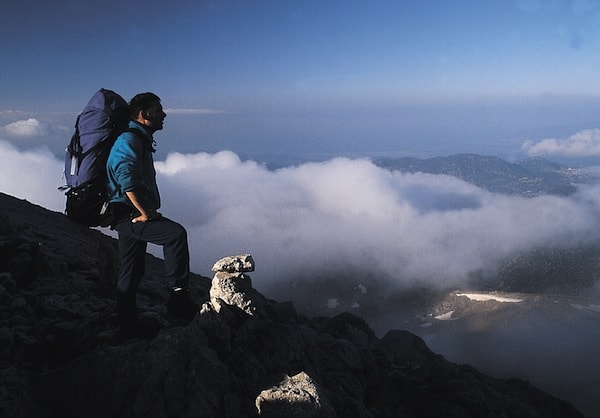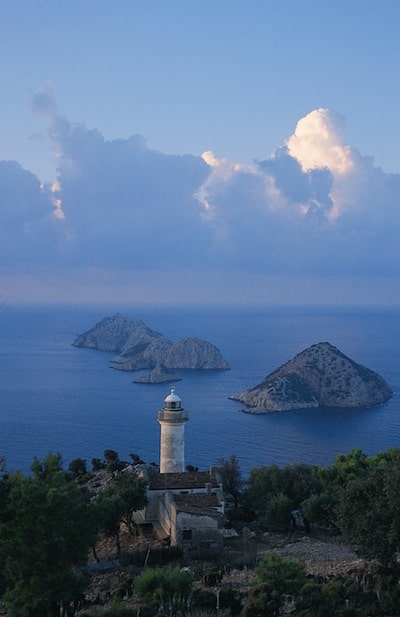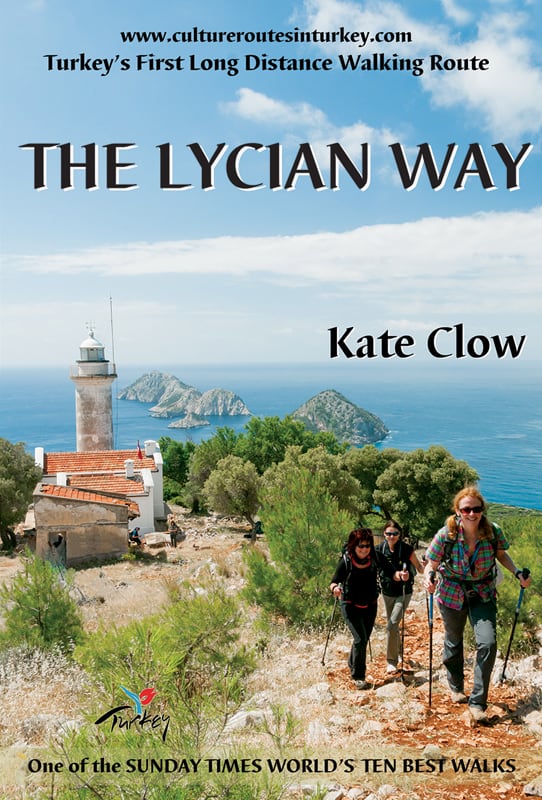Kate Clow, a long-time resident of Turkey, is a renowned sage of hiking in the region. She is best known for heading efforts to build, preserve, and facilitate accessibility to the Lycian Way, a long distance hiking path between Antalya and Fethiye. Kate has also undertaken similar projects across Turkey. Yet despite the growing number of trails and magnificent scenery, hiking in Turkey still seems to be somewhat of a secret. We got in touch with Kate in the hope that she would share some of her deep knowledge of the subject.

As an expat, how did you become so interested in hiking in Turkey, and at what point did you know that Turkey would become your new home?
I first visited Turkey in 1988 and spent three weeks trekking and visiting various historic sites. At the time, I was intending to move from the UK — I didn’t like the politics and the way it was affecting the social fabric of the country. I had thought of living in France, but that visit to Turkey convinced me that the Turkish countryside had a load to offer in terms of nature and history, and that the Turks were pretty easy to live amongst.
A project the size of the Lycian Way must have involved the cooperation of many different parties. What has the overall attitude been towards these trail projects amongst Turks?
It didn’t actually involve so many people. The local people at first thought that I was totally mad, but at the same time were quite friendly and tolerant of my madness. Now, of course, they really appreciate the trail as they are making a good living from the visitors to their pensions and cafes. So I get a really great welcome all along the trail.
The authorities were really confused — the concept of trekking tourism was completely unknown in Ankara and the Tourism, Culture and Forestry Ministries spent a year trying to pass this hot potato from one to another before we eventually got permission to mark the trail. I am really surprised by how slow their learning process has been — so many countries in the world are now totally dependent on sustainable trekking/nature tourism and the science of managing heritage tourism is now well recognized and taught at universities here in Turkey, as well as elsewhere. But even though the authorities can recognize that, in theory, this ought to change their approach to Turkish tourism, in practice it has nowhere near as much effect as, for example, the impact of new media. A prime example is the new approach of the Tourism Ministry’s promotions department to marketing — they have very successfully spent a fortune with TripAdvisor on promoting Turkey, but haven’t diversified the product they are promoting to include regional and sustainable tourism.

The portion of the Lycian Way I hiked was stunningly beautiful. Besides the scenery, what makes hiking in Turkey unique?
Turkey has two incredible advantages — it was the gateway through which humanity expanded from the Middle East to Europe, and therefore hosts a maze of old roads and paths used since the dawn of time; it also, for the same reason, hosts a real botanic and natural diversity, with far more native butterflies, birds and plants than any country of similar size.
But even if you don’t appreciate nature or old roads, you will be overwhelmed by the hospitality and friendliness of the Turks.
Can we walk the Lycian Way with just the guidebook (i.e. without a guide), or even without the guidebook? Is it also possible to make it without knowing any/much Turkish?
The trek was designed for independent trekkers; the new iPhone app makes the trail very accessible and easy to use. You don’t need a guide; if you are just walking for a day or two you don’t need the guidebook, although it is very useful background material for planning a longer trek. The website (cultureroutesinturkey.com), the book and the iPhone app are integrated: The website answers basic questions and helps you plan your holiday, the book gives detailed info on the walking conditions, the stuff you need and the facilities on the route, and the iPhone app guides you along the trail and to places where you can stay as well as interesting historical sites, etc.
Is there a portion of the trail that is your favorite for any reason? The most beautiful? The most rewarding?
I don’t really like telling people my favorite portion, partly because I have different favorites for different seasons, partly because I prefer users not to concentrate in particular spots. I like using old roads, because I enjoy speculating about their purpose and the people who made and used them, and looking for ruins in the forest or scrub. But there are some really spectacular viewpoints on the trail where you really feel high above and beyond civilization, open to the elements and in touch with yourself and the whole world. Maybe the area around Belos (between Finike and Demre) combines both these interests best.

It would be amazing to hike the whole trail, but committing to a month is difficult. What is the best way we can hike the trail in a long weekend?
From Antalya or Dalaman, you can fairly easily get to the end of the trail and start to trek from either Ovacık or Göynük. This will give you two days on the trail (with accommodation) before you take a bus back to your starting point. Also, recently we have extended the trail to Geyikbayırı, so if you are a climber you could combine trekking with climbing. And finally, you could base yourself in Çıralı or Olympos, trek a bit, swim a bit and hang out with plenty of other young people from a variety of nationalities.
Reading about the Erasmus students that got lost off of the trail this winter was scary- do you have any safety tips for hikers on trail?
They’re not the only ones to make mistakes, but it’s very easy to avoid them. Tell people where you are starting from and where you are going (the rescuers wasted two days looking in the wrong valley, because they didn’t leave exact information). Plan your route: Work out how far it is to your destination and where you will spend the night (they set out on an 11-hour hike with no hope of reaching the end in daylight). Be prepared: In winter take a tent or bivvy bag or survival sack; in summer sufficient water; always take a torch and matches/lighter (they were badly equipped). Be aware of your route: If you can’t find way marks, go back to the last one and check in a circle until you find the route (they missed a turn and carried on for a km to the edge of a canyon). Finally, take a phone and use it! (They didn’t phone until they saw a helicopter overhead!)
Do you have any other memorable stories from hiking Turkey, your own or others’, which are more encouraging than getting lost.
Yes, many, but you do tend to remember the stupid mistakes you make. One of the kindest people I remember was a goatherd called Ramazan. I had tied my dog to his fencepost, when his cow escaped and charged at the strange dog. Fortunately my rucksack ended upon the cow’s horn, while the dog slipped his collar and ran for his life, only stopping when he came to the edge of a 600m cliff. It was Ramazan who wriggled down the steep slope and pulled the dog up to safety.

The Lycian Way seems to be the most talked about trail in Turkey, but there are many other long distance trails now, including others you have founded. Is there a trail that you think is under-recognized? Which ones are must-sees?
Definitely the Carian Way will be the next successful trail, so hike it now before it becomes well-used. But for summer hiking, the Kaçkar take some beating. When the coast is hot and full of tourists, it’s possible to get away to the green yaylas and thick forests of the Kaçkar, explore old trails and abandoned villages and not see a soul for days. The east of Turkey is still under-visited and unexplored — apart from the Kaçkar, there are trails around Sarıkamiş, Kars and Ararat as well as the Abraham Path, near Urfa (although better to wait a little).
What are you working on now and what are your hopes for the future of hiking in Turkey? Is there any way we could get involved?
For the last two years, I have been working on setting up the Culture Routes Society and making it financially viable. With the help of workawayers and Erasmus students, we are just beginning to break even and to make an impression on trail tourism in Turkey. As soon as the society can support itself, I want to get back to trail making. There are two projects in particular that I would like to work on: One is an extension to the Lycian Way along the Alakır Valley (north of Finike). Another is a route connecting the ancient Selçuk capitals of Konya and Alanya.
From the point of view of the society, we have excellent links with the European Institute of Culture Routes and are close to signing an agreement to work with the Via Francigena to develop a route across Turkey which will be part of a network linking Rome with the Middle East. We are also part of the World Trails Network, which is a wide-ranging and professional organization of trail makers, and want to use this to promote the recognition of cultural and natural diversity along the trails.
In practical terms, more than anything else, Turkey needs to develop teams of trail professionals with the necessary range of skills — and it’s a huge range — to develop trails quickly and sustainably. This is gradually happening in our office, where we, with our members and friends, can now (just about) find and map our own trails, research the history and archaeology, identify the flora and fauna, maintain relations with local people and encourage them to start up accommodation, produce guidebooks, iPhone apps and websites, negotiate on conservation and permissions with the authorities, represent the trails at international meetings and welcome a wide range of drop-in visitors in several different languages. I don’t think that there is any cultural heritage management course which will teach you all of this!
So maybe the next step is to work with universities on the practicalities of their courses and student development. If any of your readers are studying relevant subjects and want to get involved over a period of a few months, please get in touch!
You can find more information on society members, contacts, trails, guidebooks, maps, and guided and self-guided tours, including biking, flower and bird tours at http://www.trekkinginturkey.com and http://cultureroutesinturkey.com. For news and events, you can also check out Culture Routes Society’s Facebook page.










It’s really nice to see a photograph of Kate Clow, her name has been banded about for years, but I have never quite met her or seen a photo of her! Although I did meet her niece in Brighton whilst learning Turkish and she almost made an appointment for a foot reflexology session!!! I would like to respectfully add that Adrasan is also a great place to base yourself to explore the Lycian way, you walk from Adrasan to Olympos along the Lycian Way and also from Adrasan to Gelidonya (as photographed in this article). You will find plenty of information in Adrasan for the Lycian Way and the hotel hosts are willing to take you various popular points along the Lycian Way to walk from. The views in this area are fabulous! Enjoy!
Such a great time I had hiking in Lycia, thanks. https://jbrasseul.wordpress.com/2010/10/19/via-lycia/
Are there hiking clubs /groups based in Istanbul? I am new in the country and do not feel like hiking on my own.
The Lady is the first person to encourage me to go on a very very long journey which started with the Lycian Way… Thank you Kate… (You might not remember me but try… I came to your house in Antalya one summer day with my wife, had a chat for a while and bought your book on Lycian Way… It was the year that an article about Lycian Way was printed in Atlas)
The Lycian Way has to be one of the best hikes in the world and Kate’s book is the perfect accompaniment. Thank you Kate!
We’ve just hiked for seven days between Fethiye and Kalkan. Quite easily the best week’s walking ever! I can’t wait to go back for the next stage. Thank you Kate, for all your work making this journey accessible through your guide.